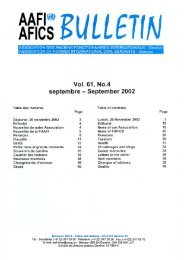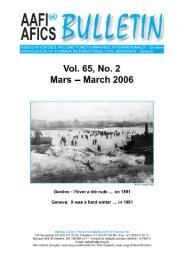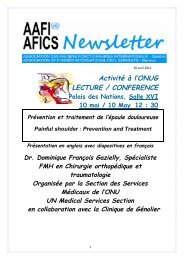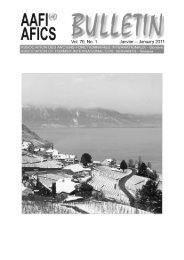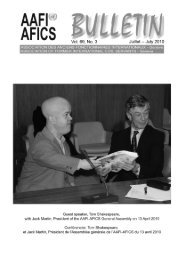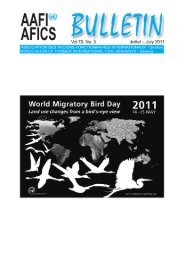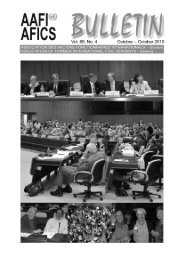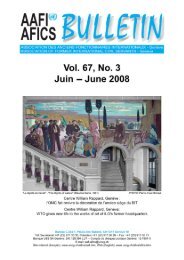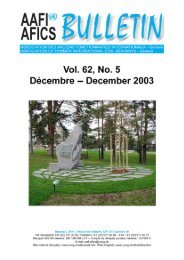VOL. 68, NO. 2 - AAFI-AFICS, Geneva - UNOG
VOL. 68, NO. 2 - AAFI-AFICS, Geneva - UNOG
VOL. 68, NO. 2 - AAFI-AFICS, Geneva - UNOG
You also want an ePaper? Increase the reach of your titles
YUMPU automatically turns print PDFs into web optimized ePapers that Google loves.
CECHY SPA TRIANGLE : HEALTH AND WELLNESS<br />
This follows an <strong>AAFI</strong>-<strong>AFICS</strong> group travel visit to Prague, Ceske Budejovice, Cesky Krumlov, Karlovy Vary,<br />
Dresden (29 September - 6 October 2008).<br />
Formerly a Slavic kingdom, Bohemia became a province of the newly formed Czechoslovakia by the Treaty<br />
of Versailles in 1919. The region of Cechy in the western part of independent Czech Republic consists<br />
chiefly of a plateau closed by mountains that has been a destination for prospectors, Christian pilgrims, spa<br />
visitors and nature lovers.<br />
Amongst the historical, architecture, leisure and natural features, it is endowed with therapeutic minerals<br />
from its deep thermal springs and hot mud pools. Its mountains and forests are protected as natural<br />
monuments or reservations. There are many rare flower and plant species with marshes, natural lakes and<br />
bog lands. Nature trails can be explored that are designed to protect rare animal species, bog vegetation,<br />
salty swamps and other unique features that have formed during different geological periods of the region.<br />
Some 150 years ago the Cechy Spa triangle of Marianske Lazne, Karlovy Vary, Frantiskovy Lazne was a<br />
fashionable European centre. “Taking the waters” in the historical towns were the powerful and rich from<br />
Europe and the wider world including emperors and tsars, kings and sheikhs, aristocrats, artists and people<br />
from the rich upper middle class. Those who could not afford to stay in the spas could have the healing water<br />
delivered while the poorest could draw it directly from the natural thermal springs.<br />
Between the late nineteenth century and start of World War I the so-called Golden Age of the Cechy Spa<br />
triangle saw the construction of elegant colonnades in the towns. Intended to enable walking and drinking of<br />
mineral water directly from the springs, they became part of the spa social life for the rich visitors. These ‘airy<br />
temples’ of healing waters took on a life of their own and remain features of the spa towns today. The<br />
colonnades are popular with visitors who continue to drink water from the thermal springs.<br />
After a period of steep decline, more recently the region of the Cechy Spa triangle has been revitalised<br />
offering modern facilities of balneology in its many spas throughout the region. In the footsteps of rich and<br />
famous, the historical towns provide a variety of medical and dietary cures targeted to treat specific health<br />
disorders while others focus on regeneration of health and wellness, relaxation, cosmetic and related<br />
treatments.<br />
In addition to the imperial elegance of buildings with Baroque and other periods of architecture, luxury hotels<br />
and shops, the spa towns boast miraculous healing effects for curists … that could be related to blessing of<br />
the springs that opens the new spa season … in Karlovy Vary.<br />
Called the ‘thirteenth spring’, for two centuries a popular Czech herbal liqueur Becherovka “invented” by a<br />
local pharmacist has a reputation for ‘healing power’.<br />
Ita Marguet<br />
BOOK REVIEW<br />
Equality of Men and Women at Work<br />
Eve C. Landau and Yves Beigbeder (<strong>AAFI</strong>-<strong>AFICS</strong> Committee member) have just published “From ILO<br />
Standards to EU Law: The Case of Equality between Men and Women at Work” (Martinus Nijhoff Publishers<br />
2008). The Foreword has been written by Emeritus Professor and Judge Lucius Caflisch, at present Member<br />
of the UN International Law Commission.<br />
The book portrays the achievements and progress of equality at work between men and women. The<br />
relevant UN Conventions and the numerous ILO Conventions and Recommendations are recalled. The<br />
European Union has applied and developed the universal ILO standards, empowering rights of equality with<br />
effective remedies through EU legislation and enforcement by its Court of Justice. The issues covered<br />
include equal remuneration and treatment, positive or affirmative action, dignity of the worker, maternity<br />
38



